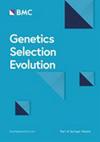牛社会优势的直接和间接遗传成分与适合度和形态性状的遗传相关性
IF 3.6
1区 农林科学
Q1 AGRICULTURE, DAIRY & ANIMAL SCIENCE
引用次数: 0
摘要
在同一物种中,个体在社会支配地位上表现出明显的差异。对少数种群的研究表明,这种性状具有可遗传的遗传变异,这是由个体的遗传背景(直接遗传效应)和其对手的遗传背景(间接遗传效应)共同决定的。然而,这一特征的选择的进化结果在很大程度上是推测性的,因为它不是牲畜种群选择的通常目标。此外,研究社会支配地位提出了一项挑战,即研究具有在种群中不能改变的平均值的表型,因为每一个竞争相互作用的赢家必然会有一个输家。因此,为了研究社会优势选择的进化反应,有必要关注可能与之相关的特征。本研究探讨了社会优势与若干形态和适合度性状的直接和间接遗传相关性。我们使用了一个涉及牛(Bos taurus)的竞争竞赛数据集:在这些竞赛中,成对的牛在仪式化的互动中竞争,以评估社会支配地位。研究人员将8789头奶牛在20年间进行的37,996次优势相互作用的结果与生育力、乳腺健康、产奶量和形态的个体数据相结合,并使用包括间接遗传效应在内的双变量动物模型进行分析。我们发现,获胜的激动相互作用与更发达的额肌质量、较低的生育能力和较差的乳房健康状况具有正相关的遗传关系。我们还发现,社会优势、乳房健康和更发达的肌肉质量的估计育种值的变化趋势与群体中社会优势的选择一致。我们提供的证据表明,社会优势与健康特征在遗传上相关,以及这些特征之间可能的进化权衡的经验证据。我们表明,估计涉及二元社会特征的遗传相关性是可行的。本文章由计算机程序翻译,如有差异,请以英文原文为准。
Genetic correlations of direct and indirect genetic components of social dominance with fitness and morphology traits in cattle
Within the same species, individuals show marked variation in their social dominance. Studies on a handful of populations have indicated heritable genetic variation for this trait, which is determined by both the genetic background of the individual (direct genetic effect) and of its opponent (indirect genetic effect). However, the evolutionary consequences of selection for this trait are largely speculative, as it is not a usual target of selection in livestock populations. Moreover, studying social dominance presents the challenge of working with a phenotype with a mean value that cannot change in the population, as for every winner of an agonistic interaction there will necessarily be a loser. Thus, to investigate what could be the evolutionary response to selection for social dominance, it is necessary to focus on traits that might be correlated with it. This study investigated the genetic correlations of social dominance, both direct and indirect, with several morphology and fitness traits. We used a dataset of agonistic contests involving cattle (Bos taurus): during these contests, pairs of cows compete in ritualized interactions to assess social dominance. The outcomes of 37,996 dominance interactions performed by 8789 cows over 20 years were combined with individual data for fertility, mammary health, milk yield and morphology and analysed using bivariate animal models including indirect genetic effects. We found that winning agonistic interactions has a positive genetic correlation with more developed frontal muscle mass, lower fertility, and poorer udder health. We also discovered that the trends of changes in the estimated breeding values of social dominance, udder health and more developed muscle mass were consistent with selection for social dominance in the population. We present evidence that social dominance is genetically correlated with fitness traits, as well as empirical evidence of the possible evolutionary trade-offs between these traits. We show that it is feasible to estimate genetic correlations involving dyadic social traits.
求助全文
通过发布文献求助,成功后即可免费获取论文全文。
去求助
来源期刊

Genetics Selection Evolution
生物-奶制品与动物科学
CiteScore
6.50
自引率
9.80%
发文量
74
审稿时长
1 months
期刊介绍:
Genetics Selection Evolution invites basic, applied and methodological content that will aid the current understanding and the utilization of genetic variability in domestic animal species. Although the focus is on domestic animal species, research on other species is invited if it contributes to the understanding of the use of genetic variability in domestic animals. Genetics Selection Evolution publishes results from all levels of study, from the gene to the quantitative trait, from the individual to the population, the breed or the species. Contributions concerning both the biological approach, from molecular genetics to quantitative genetics, as well as the mathematical approach, from population genetics to statistics, are welcome. Specific areas of interest include but are not limited to: gene and QTL identification, mapping and characterization, analysis of new phenotypes, high-throughput SNP data analysis, functional genomics, cytogenetics, genetic diversity of populations and breeds, genetic evaluation, applied and experimental selection, genomic selection, selection efficiency, and statistical methodology for the genetic analysis of phenotypes with quantitative and mixed inheritance.
 求助内容:
求助内容: 应助结果提醒方式:
应助结果提醒方式:


